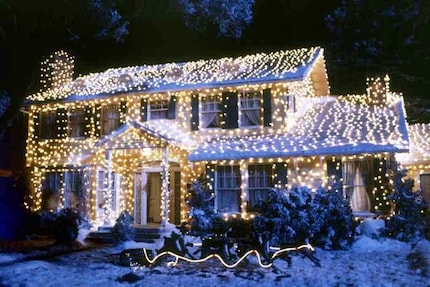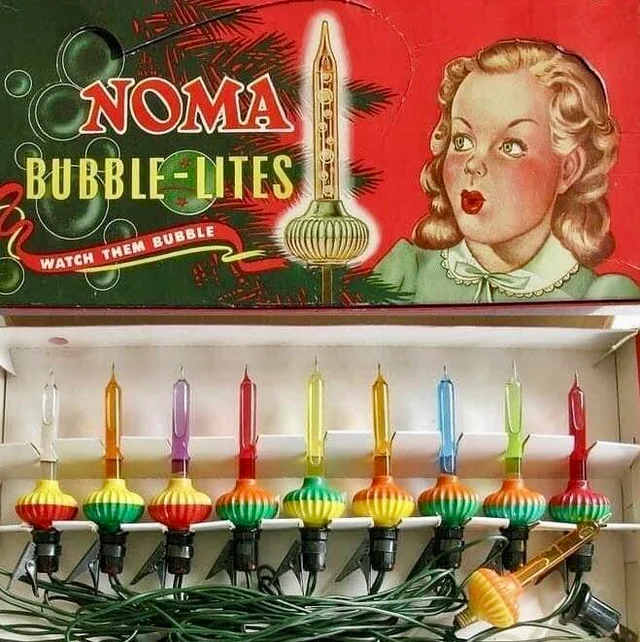
Background information
Why do we actually light up the Christmas tree?
by Carolin Teufelberger

Our ancestors would make the darker months more bearable by lighting candles. What used to be humble flickering flames has evolved into blinding light shows that are anything but cosy.
When I think of Christmas lights, the Griswold family comes to mind. In the 1989 cult comedy National Lampoon’s Christmas Vacation, the OTT Christmas lights are probably what you remember best. Family man Clark Griswold spends days putting up every single light bulb. After he’s finally done and it’s time to switch it all on, the lights are so bright the neighbours are blinded and the local power plant has to switch to emergency power.
The Romans organised Saturnalia in honour of the god Saturn. These celebrations took place at the end of December and often involved lights. In Norse mythology, there were customs related to the winter solstice, such as the Yule festival.
The Christmas tree, on the other hand, is a fairly recent invention. The first written record of a decorated Christmas tree dates back to 1510. The chronicle of the city of Riga mentions a tree that was erected at the marketplace by the Brotherhood of Blackheads. Even back then, the tree was illuminated.
A few decades later, in 1539 to be precise, the tree made it to Germany. Some sources state that a tree was put up in the guild room of the «Heiliggeist» Hospital in Freiburg. There are also reports of trees being put up in houses and decorated with «apples, wafers, gold tinsel and sugar» in Strasbourg, which is now part of Alsace, back in 1605.
Even Catholics had got used to the idea of this popular way of decorating a room. The Christmas tree, as it was now called, became a symbol of the «light of the world» that Jesus has brought to earth by being born.
The first trees were lit up with real candles, if at all. This was dangerous and often caused fires. A bucket of sand or water was therefore often kept next to the tree for emergencies. Metal candle holders for attaching the candles to the branches weren’t available until around 1820. The clamp candle holder was patented in Germany in 1867. Before that, candles were mounted directly on the branch.
For a long time, electric fairy lights were only found in wealthy households. It wasn’t until the 1930s that fairy lights became more affordable. What was known as «bubble lights» were typical for that time. They were light bulbs containing a liquid that created bubbles when it was heated. These days, you can get retro models of them.
In the 1960s and 1970s, the lamps became smaller and were modelled on real candles in some cases. You could purchase and replace individual «candles» if they broke.
This retro design’s making a comeback. Modern-day versions in the style of classic electric Christmas tree candles are now available with LEDs, remote control and a large choice of RGB colours.
And in the 1990s, the first LED fairy lights hit the shelves. Today, an almost infinite number of models are available. Some LEDs pulsate, change colour or glow cold or warm. They can be used to create effects Edward Johnson and his colleagues probably never even dreamed of.
And this is just a small selection. Here you’ll find many, many, many more fairy lights.Journalist since 1997. Stopovers in Franconia (or the Franken region), Lake Constance, Obwalden, Nidwalden and Zurich. Father since 2014. Expert in editorial organisation and motivation. Focus on sustainability, home office tools, beautiful things for the home, creative toys and sports equipment.
Interesting facts about products, behind-the-scenes looks at manufacturers and deep-dives on interesting people.
Show allThis is less likely to happen these days, since Christmas lights are usually less power-hungry thanks to LEDs. However, this hasn’t made illuminated decorations more modest. On the contrary. In the USA and Canada, people even enter their houses in competitions for the most beautiful, creative or elaborate lighting. In many places there’s even a Griswold Award up for grabs, as in Richmond Hill, Ontario, Canada.

Back in the day, humans used to be more frugal. Even in pre-Christian times, it was customary to light candles. Especially for the winter solstice, which falls on 21 December according to our modern-day calendar, people would light candles to light up the longest night of the year. Researchers have dated the earliest evidence of ritual fire to around 4,000 to 6,000 years ago. Archaeological finds from the Neolithic period include fireplaces in stone circles and other astronomically oriented structures.
Putting up decorated Christmas trees only became really popular in the 19th century. Before that, it was more of a thing in cities and with Protestant families. The Catholic Church was initially sceptical about the custom. At some point, however, there was no stopping it. Prussian King Frederick William IV popularised the decorated Christmas tree at court. Around the same time, the custom was introduced in England in 1840 by the aristocracy, specifically Queen Victoria and Prince Albert. By the end of the 19th century, Christmas trees could be found in almost all Christian households. It even made it to North America because of German emigrants.
Electric lighting began to appear around the end of the 19th century. It was Edward Johnson, an employee light bulb inventor Thomas Alva Edison, who’s said to have been the first person to decorate a Christmas tree with electric lights in 1882. To decorate a tree in New York, he had handmade a chain of 80 red, white and blue light bulbs.
